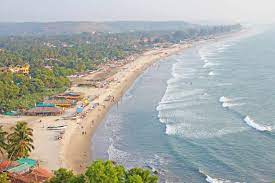Goa is located on the western coast of India and bordered by the Arabian Sea, experiences a tropical monsoon climate, which is influenced by its coastal location and proximity to the sea. The climate of Goa can be broadly categorized into three main seasons: summer, monsoon, and winter.

Summer (March to May)
-
- Summers in Goa are hot and humid, with temperatures ranging from 28°C to 35°C (82°F to 95°F).
- Coastal areas tend to be slightly cooler due to the moderating effect of the sea breeze, making them more comfortable during the day.
- The humidity levels can be relatively high during this season, adding to the perception of discomfort.
Monsoon (June to September):
-
- The monsoon season is the most crucial period for Goa’s climate, as the state receives the majority of its annual rainfall during this time.
- The southwest monsoon, originating from the Arabian Sea, brings heavy rainfall to the region, rejuvenating the landscapes and replenishing water bodies.
- The lush greenery, waterfalls, and fresh water streams during the monsoon months attract many tourists to Goa.
Winter (October to February):
-
- The winter season in Goa is pleasant and mild, with temperatures ranging from 20°C to 32°C (68°F to 90°F).
- The climate is comfortable and enjoyable, making it an ideal time for tourists to visit the state.
- During this season, the weather is relatively dry and sunny, creating a perfect ambiance for beach activities and outdoor excursions.
Goa’s climate is influenced by its coastal location and the Arabian Sea. The sea breeze helps moderate temperatures in the coastal areas, making them more bearable during hot summer months. The state’s proximity to the sea also leads to higher humidity levels, especially during the monsoon season.
The monsoon season plays a vital role in supporting the state’s agriculture, particularly the cultivation of rice and other crops. Additionally, the monsoon enhances the beauty of Goa’s lush landscapes and contributes to the state’s rich biodiversity.
According to the Koppen climate classification scheme, Goa’s climate is classified as a Tropical Monsoon Climate (Am). This classification is consistent with the fact that Goa experiences distinct wet and dry seasons, typical of tropical monsoon regions.
Tropical Monsoon Climate (Am)
-
- The Am climate is characterized by high temperatures throughout the year and a distinct wet season, which is the monsoon season.
- Summers in Goa (March to May) are hot and humid, with temperatures ranging from 28°C to 35°C (82°F to 95°F).
- The monsoon season (June to September) brings heavy rainfall to the region, with the majority of the annual precipitation occurring during this period.
- Winters (October to February) are mild and pleasant, with temperatures ranging from 20°C to 32°C (68°F to 90°F).
The influence of the Arabian Sea, located to the west of Goa, plays a significant role in shaping the state’s climate. The sea breeze helps moderate temperatures along the coast, making it relatively cooler than inland areas during hot summer months. Additionally, the proximity to the sea contributes to higher humidity levels, especially during the monsoon season.
Goa’s tropical monsoon climate is conducive to lush vegetation, making it a green and picturesque destination. The monsoon season is vital for agriculture and water resources, supporting the growth of crops and replenishing water bodies. The state’s pleasant winter climate attracts tourists, making it a popular destination for both domestic and international travelers seeking respite from colder regions.
Overall, Goa’s tropical monsoon climate, with its warm and humid summers, abundant rainfall during the monsoon season, and pleasant winters, makes it a popular tourist destination throughout the year. The climate, along with its vibrant culture, picturesque beaches, and diverse attractions, attracts travelers from around the world to experience the charm of this coastal paradise.
Important Links